


There are two main organizations that sanction model boat racing in the US and Canada, They are the International Model Power Boat Association (IMPBA) and the North American Model Boat Association (NAMBA). If you want to race model boats, you are probably going to have to join one of these organizations. Their purpose is to provide a common set of rules, classes and safety standards to race under. They also provide insurance to racers, clubs and pond owners in the event of an accident. Both organizations generally run similar classes and rules but they do have their subtle differences. Which organization best suits you is most dependent on where you decide to race. The IMPBA is the predominant sanctioning body in certain parts of the country while NAMBA clubs are prevalent in other regions. Do some research on both the IMPBA and NAMBA web sites. Each site contains a map showing each districts area of jurisdiction. The sites will also include a list of all clubs within the district and contact info for both district and club officers. Once you find the club or district that best suits your needs, drop them an email or give them a call. Other ways to learn where boating activities are in your area include visiting your local hobby shop or joining one of the boating boards on the internet.
Once you have completed the research and have a pretty good idea which sanctioning body is best for you, you will probably find yourself in one of two scenarios. In the first one, you have found a club close by that fits the bill and your ready to join. Well consider yourself lucky but don't go out and buy a race boat yet. There are other things to consider that will be covered shortly. Go visit the club next time they are at the pond, meet the members and check out all the fun you're going to be having. Spending a beautiful afternoon running boats and exchanging tips with people that share your interests makes the hobby so much more enjoyable. If you join a club with large membership, there is a chance they run their own series racing every few weeks. Smaller clubs will be more informal. They are more likely to run for fun and boat testing every few weeks, and maybe host a district race once or twice a year.
In the second scenario there are no clubs close enough for you to be worth joining, but you are still willing to travel to get in on the racing action. In this case my suggestion is to take a road trip and attend a race to see if it's something you truly want to pursue. Don't just watch the racing while you're there. Walk around, talk to the racers and ask questions. Racers love talking about their boats and want to see new racers in the hobby. Chances are you are going to be hooked. Remember, you do not have to be a member of a club to participate in a district or national race. You must only be a member of the organization (IMPBA or NAMBA) which sanctions that race. Probably half the racers in my district fall under this category.
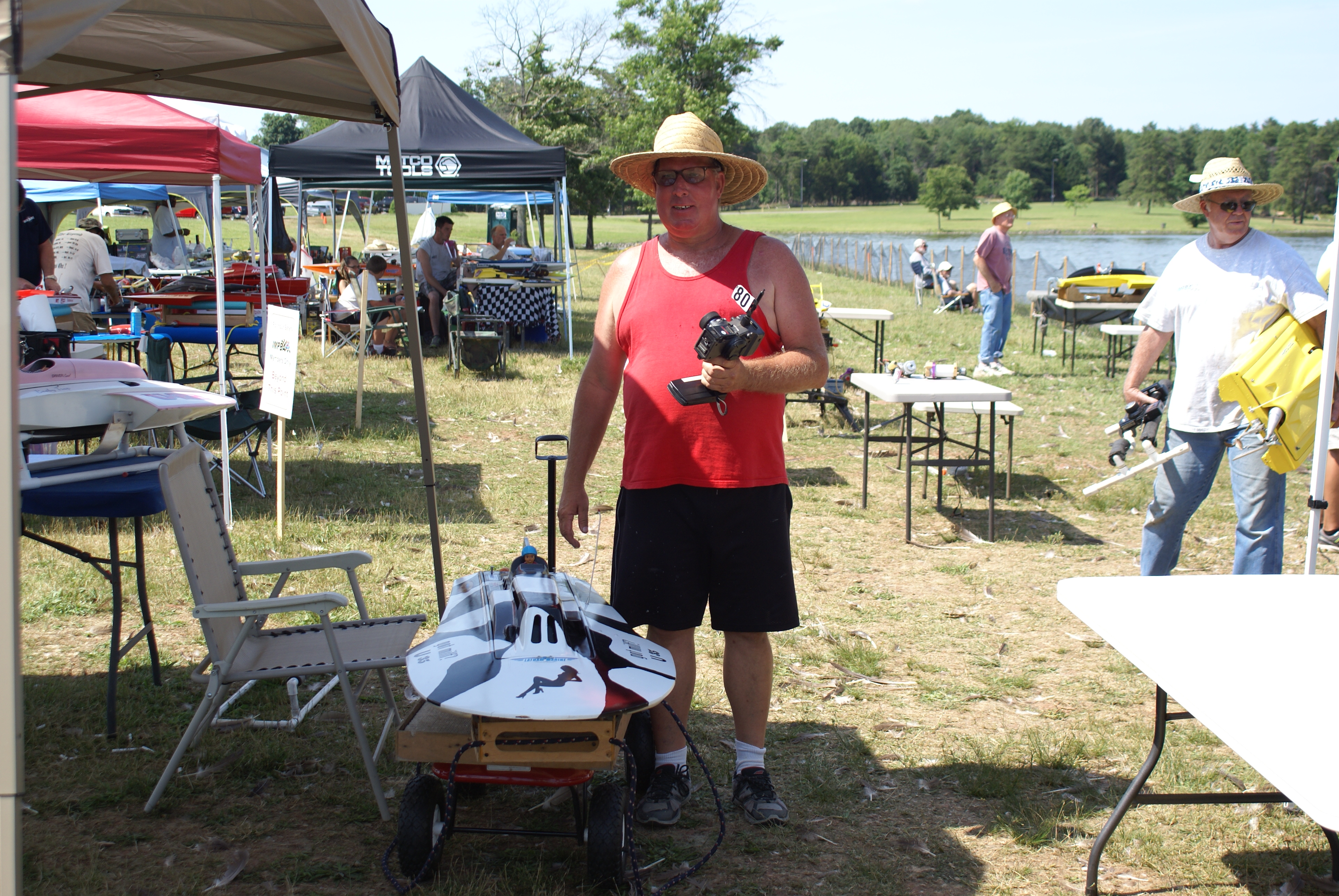
So you decide you are ready to take the plunge. Before choosing a boat, you need to consider what class you want to race in. The IMPBA and NAMBA give their districts the autonomy to create and run classes to meet the needs of its members. No two districts are exactly alike. There are many classes available in the IMPBA and NAMBA rule book. Classes are based on power (gas, nitro, electric), hull type (mono, hydro, tunnel, etc.) and size. Just because you want to race a nitro powered catamaran doesn't mean they have class for it in your district. You need to first find out what classes your district run and choose a boat to fit in one of those classes. If you are interested in gas powered boats, the odds are most districts will have class for you as gas is probably the most popular power choice these days. Nitro outboard tunnels are very popular in the southeast but not in other parts of the country. Fast Electrics are gaining popularity every year but have still not caught on in some districts. So learn what classes are in your district before you buy.
Now it's finally time to talk about race boats. Here is a question I often read potential new racers ask on the FE boards and occasionally on the gas boards. "What can I do to hop up the ready to run (RTR) boat I purchased at the hobby shop to make it competitive for racing?" Well to be honest there are few, if any mass produced RTR boats that can compete with the better racing hulls on the water. The few exceptions might be in the FE Limited classes which use smaller boats and restrict power. The problem with most RTR's is the design of the hull. Race water can get very choppy and RTR boats are just not designed to run in the racing environment. I have seen a few RTR's that were pushed hard and got beat up pretty bad. I have even a FE hull or two get destroyed in a heat without even touching another boat. If your only option is to run an RTR or you're not ready to invest in a custom boat, by all means get out there. You'll learn how to race, learn about boat set up and you'll still have a great time. As long as you are in control of your boat and holding your lane while racing, the faster boaters shouldn't have any problems with you.
When you find yourself ready to build or purchase a race boat, I'm going to ask you again to please do your homework. Hit the boating forums and talk to district and club members. Tell them what class you are interested in and ask for recommendations on a hull, motor or boat builder. You might notice there are some regional favorites and there is nothing wrong with that. Take note of what boats are competitive at the races you attend. It won't take long before you find a boat that fits the bill. I do want to warn you about predators that target new boat buyers. Be aware of those that seek you out trying to sell or build you a boat. Be wary of deals that are too good to be true or deals offered on the boating board by personal message. Always get multiple opinions before your first purchase. Boaters want a new racers first race to be a good experience and we hate seeing a new boater getting duped.
You're getting close now. You've got a boat and that first race you've been working for is marked on the calendar. Try to prepare yourself and your boat as much as possible. Go to the pond as often as you can to get comfortable with the boat and iron out any problems that may arise. A race weekend is the absolute worst time to maiden a new boat if you are a freshman racer. The odds are very high that you will need a hand setting it up. And as willing as boaters are to help out a new racer, they will be busy preparing to race themselves. There just may not be enough time for them to lend you a hand.
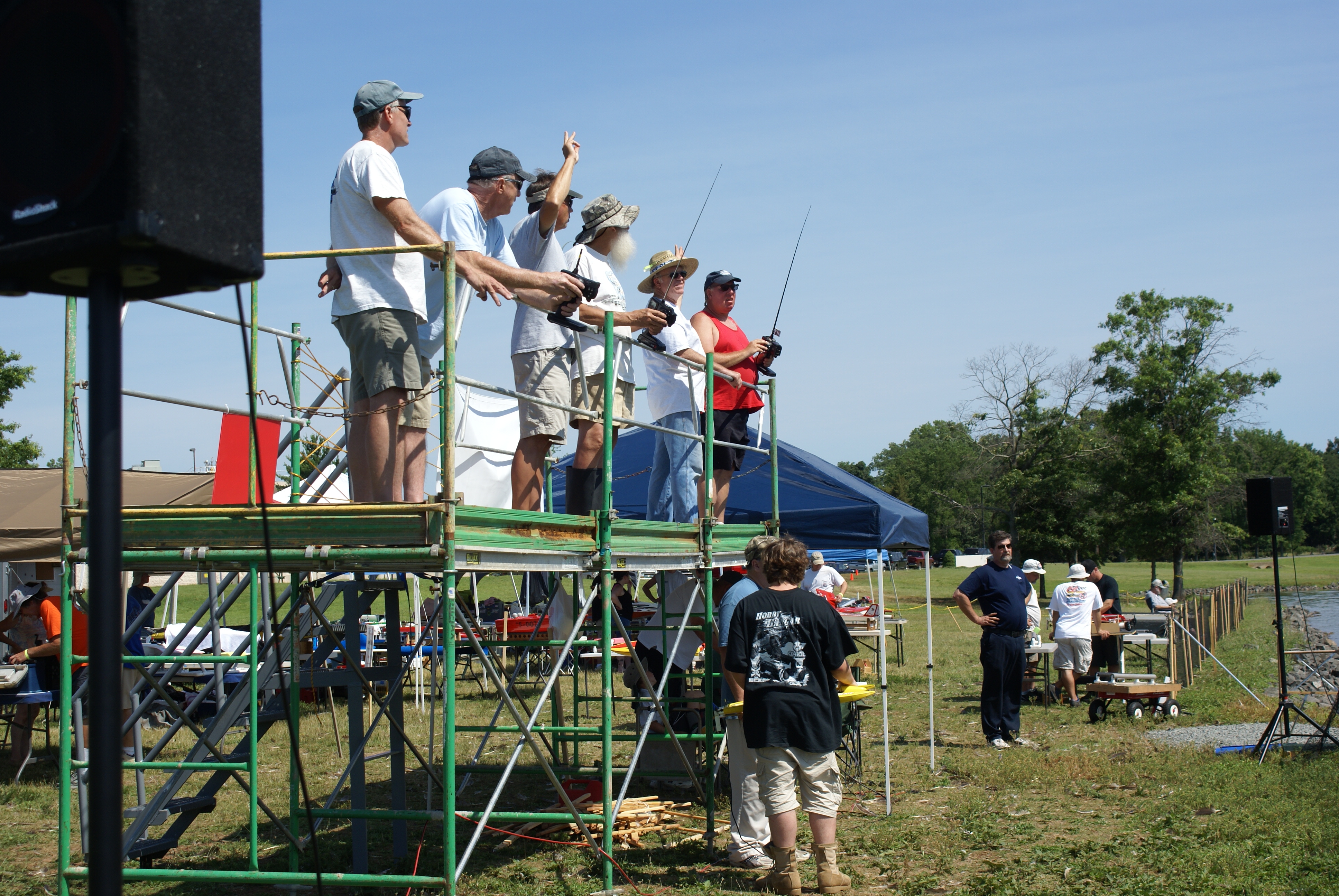
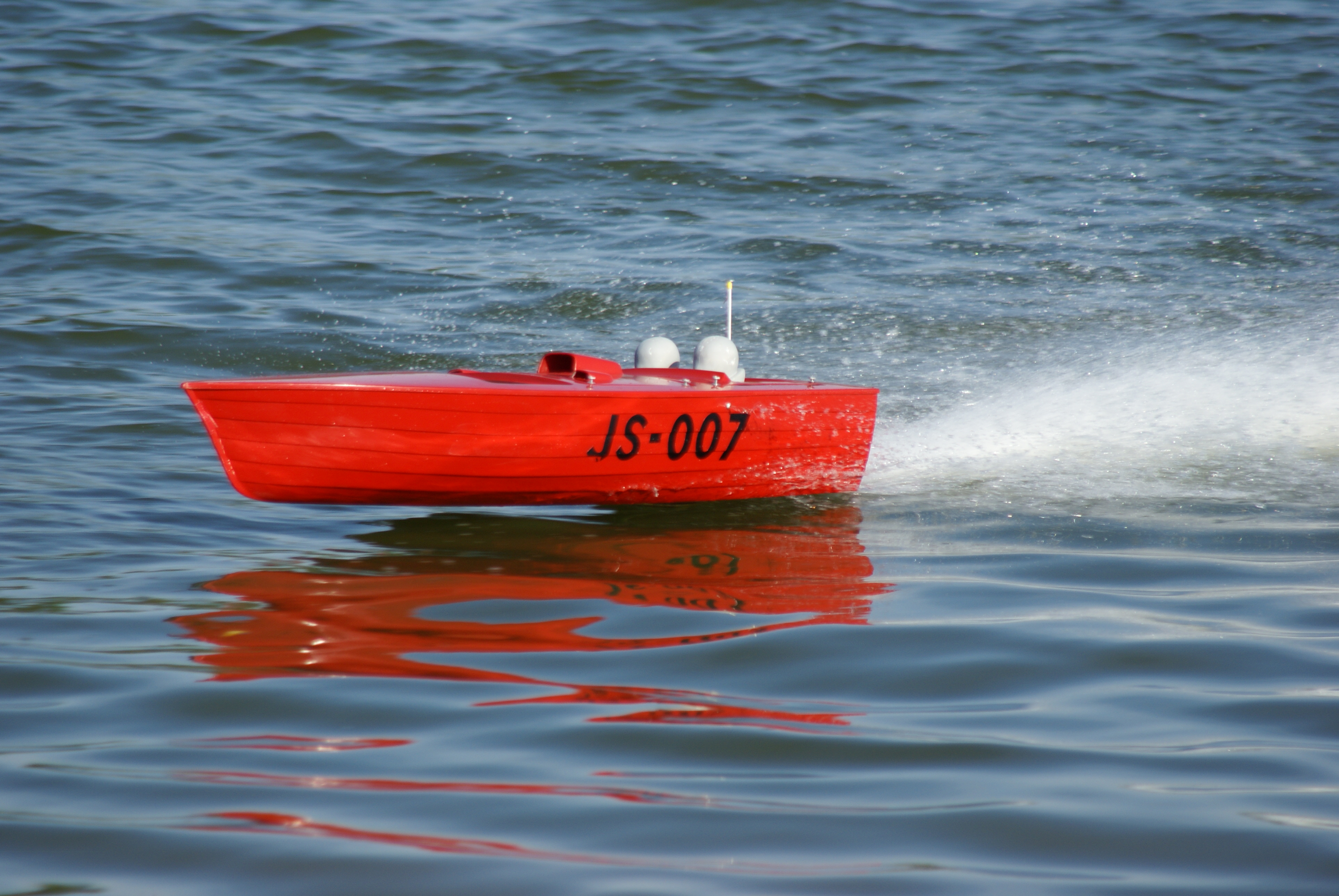
Now that you're ready to attend your first race, I'm going to walk you through a typical race weekend in IMPBA District 12. I will also give you some tips on how to make it through the weekend while avoiding errors new racers typically make. First, please make sure you read and understand your rule book before attending your first race. You especially need to know the rules of competition and safety guidelines. Also make sure to be prepared as you would for any outdoor activity to stay comforatble. It's not uncommon to be at the pond for ten hours on a race day in my district. Make sure you bring plenty of drinks to stay hydrated, snacks, sun screen, bug spray, hat's, sunglasses and rain gear. Sometimes ponds are in isolated area's and you don't want to drive for an hour looking for and item and possibly miss a heat. Many clubs will have lunch available for a reasonable fee. Know before you go and and try to patronize the club if possible to help them make a few extra bucks.
Race preparation starts a few days before the race weekend for the host club. Club members will get the drivers stand up, set up the PA system, rope off the hot pit area, mark the parking areas, set up a registration table, put out buoys and install safety netting. It is allot of work. Usually around noon on Friday we will open registration up and start open water practice. Racers will start to arrive late morning before test and tune starts. We are not required to be at the race site on Friday. But those that do arrive on Saturday morning must do so early enough to register, set up their pit area, prepare for the race and attend the drivers meeting. Unless you are one of the first participants to arrive at a race, you can generally follow everyone else’s lead in regards to where to park your car, trailer (if you have one) and where to set up your canopy and tables. If there is any doubt, ask someone
Registration: Racers should check in with the host club when they first arrive at the race site. You will be required to show an IMPBA card. You will receive a slip of paper showing what heats you will run in and what frequency to use for each heat if you are not using a 2.4 GHz radio. Always review your heat sheet and make sure you are registered in the classes you signed up for. Mistakes happen. The earlier you catch them, the better. Last second changes can cause significant delays on race day.
Transmitter’s that are not 2.4 GHz must be quarantined. They will usually be on a table close to the pits. If your boat is not in the water or in the hot pit, the transmitter should be on the quarantine table. When you are ready to run, get your transmitter from quarantine. Grab the clip with the channel number you are running and clip it on the antenna of your transmitter. After you are done running your boat, grab it from the water, turn off the boats receiver switch, turn off your transmitter, put the clip back on the board and put the transmitter back in quarantine.
The Hot Pit Area is a small roped off that is restricted to IMPBA members only. It is close to the launch area and is the only place you are allowed to fire up your boat. Contestants will set up small tables in the hot pit to start up their boats and will leave them there for the day. Obviously it would be crowded if everyone who entered the race had a pit table. So racers usually don’t mind you using their table as long as it’s not being used by them. There will be a Pit Manager (sometimes called pit boss) in the launch/hot pit area while boats are running. The pit boss is in charge of keeping the area safe and orderly. Listen to him and feel free to ask him any questions.
Open water is held on Friday afternoon for contestants to check out their boats, make final adjustments and get familiar with the race course. All classes often run at the same time, but sometimes they may segregate smaller boats. Don't forget to use a frequency clip if you are not using a 2.4 GHz radio. The frequency clip board is usually located close to the hot pits or driver's area. When you are running in open water, make sure you always run the full course around the buoys (clockwise), especially if there are other boats in the water. There will be a retrieval boat for recovering disabled boats. Do not run your boat while the retrieval boat is recovering boats.
The host club will usually assign retrieval boat duty to a host club member. These poor souls need a break every once in a while so feel free to ask the host club if you can use their retrieval boat if your boat becomes disabled during open water. If they say yes and you are not familiar with the operation of their boat, don’t be afraid to ask them give you a quick check out. Before you take the boat out, make sure there is a personal flotation device in the boat for everyone aboard. If retrieving a Fast Electric boat, keep clear of the propeller at all times and keep the prop clear of obstructions, even if the boats receiver it turned off.
RACE DAY: Race day starts Saturday morning in District 12 with the drivers meeting usually at 8am sharp. The Contest Director (aka Course Director or CD) will go over the schedule, rules and safety guidelines for the weekend. The meeting doesn’t usually take more than 15 minutes. The racing starts shortly after the drivers meeting, so if you did not register on Friday you want to arrive early enough to give yourself time to set up. Register as soon as you can after arrival, so you know what your heat numbers will be. This will give you an idea how much time you have before your first heat. You will need a pit man while you run your heats. He or she must also be an IMPBA member. The pit man will launch your boat, be your spotter during the heat, call out dead boats or other obstacles, count laps for you and pull your boat out of the water at the end of the heat. If you need a pit man ask a club member or pit neighbor. If all else fails, let the contest director know a heat or two in advance and he will ask for volunteers over the PA system.
When you are unpacked and your pit area is set up, ensure your boat is ready to race. Gas and nitro guys, make sure you're fueled up. Hook up your receiver battery to make sure you have power to the receiver and tape up your radio box. If not using 2.4 GHz, remember your transmitter is in quarantine and other boats may be using your frequency so you may get some servo glitching when you turn the receiver on to check it. FE racers, you want to tape up one heat in advance so you are ready to go when the heat preceding yours starts. This way you can pay attention to what is going on in the preceding heat and be ready to roll as soon as it finished. There are a ton of heats to run in a weekend and you do not want to cause any delay.
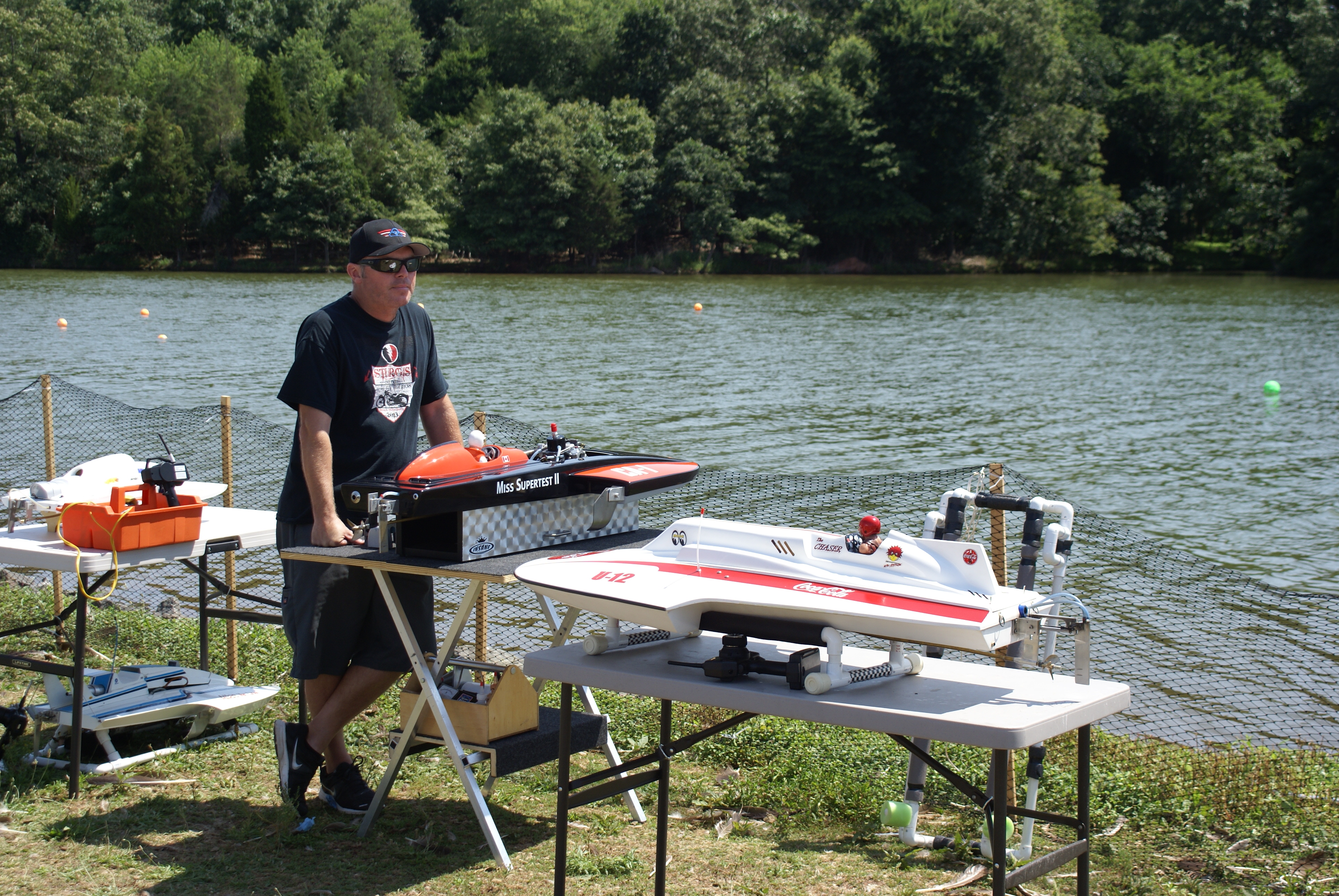

Time to Race: As the preceding heat finishes up, grab your boat, get your transmitter out of quarantine (if applicable) and stand off to the side as there will be allot of traffic coming off the driver's stand. If you still don’t have a pit man, remind the CD to ask for a volunteer. After the drivers from the previous heat clear the area, grab your channel clip (if applicable) and clip it to your antenna. Head over to the pit area and wait for the CD to start the clock for the next heat. Make sure your transmitter and boat receiver are on and ensure your servos and/or ESC are working properly. The heat will begin with the start of a two and a half minute countdown clock. The clock can be either audio or visual. When the clock starts, the heat is in what is called “Pit Time”. You now have two minutes to get your motor started and boat in the water. If all goes well, your pit man will launch the boat before the 30 seconds mark. Be sure to scan the front straightaway just before your boat gets launched. When it hits the water, make sure to give way to all boats already on the course. That means do not head directly toward buoy one when other boats are coming down the front straightaway. Take an outside lane, get up to speed and adhere to the course driving rules. At 30 seconds, “Pit Time” ends and “Clock Time” begins. Boats are no longer allowed to launch. As you run laps around the course during pit and mill time, your goal is to time your laps so that you cross the start finish line when the clock reaches zero. Once your boat starts the mill, it must remain running on plane. You cannot S-turn to scrub off time. If you find yourself on the back straight and think you will be early for the start, you can extend the back straightaway as long as you give way to other boats on the course. If you choose to slow down, the boat’s nose cannot settle into the water. If you do cross the line early, your first lap does not count and your heat does not start until you come back around and cross the start line again. All the heat racing rules and penalties are in the IMPBA rule book Chapter “G”.
The race starts with the blare of a horn and you’re off. If everyone hits the start together, the first turn can get a little hairy because everyone’s rooster tail can obscures the view of your boat. If your on the inside lane (lane 1), try to stay tight against the buoys. If you’re on the outside, take the turn a little wide. If you’re in one of the middle lanes try to hold your lane the best that you can. Don’t set your goals too high the first few heats. Winning should be the last thing on your mind. Spend your first few times on the course learning how to control your boat, hold your lane and race cleanly. The goals for my first race were to simply finish the heat and to not take anyone out. More tips for your first few heats. Don’t panic if a faster boat is coming up behind you for the pass. Just drive your boat and concentrate on holding your lane. The worst thing you can do is to attempt to get out of the way by changing lanes as a faster boat approaches. This can lead to a mishap. Also don’t get tunnel vision by focusing directly on your boat. Scan slightly ahead to help set you up for the turns and prevent whacking buoys, dead boats and even the bank. Listen to your pit man and the CD, especially for info on dead boats. If you hit a dead boat, you will be disqualified for that heat. Hitting a dead boat is something you want to avoid at all costs. It's not a good way to make friends. Never cut across the race course or make a 360 degree turn if you miss a buoy. If your boat starts acting erratically, pull it off the course before you cause an accident. Again, if you are an IMPBA member, review chapter “G” in the rulebook “Course Driving Rules”.
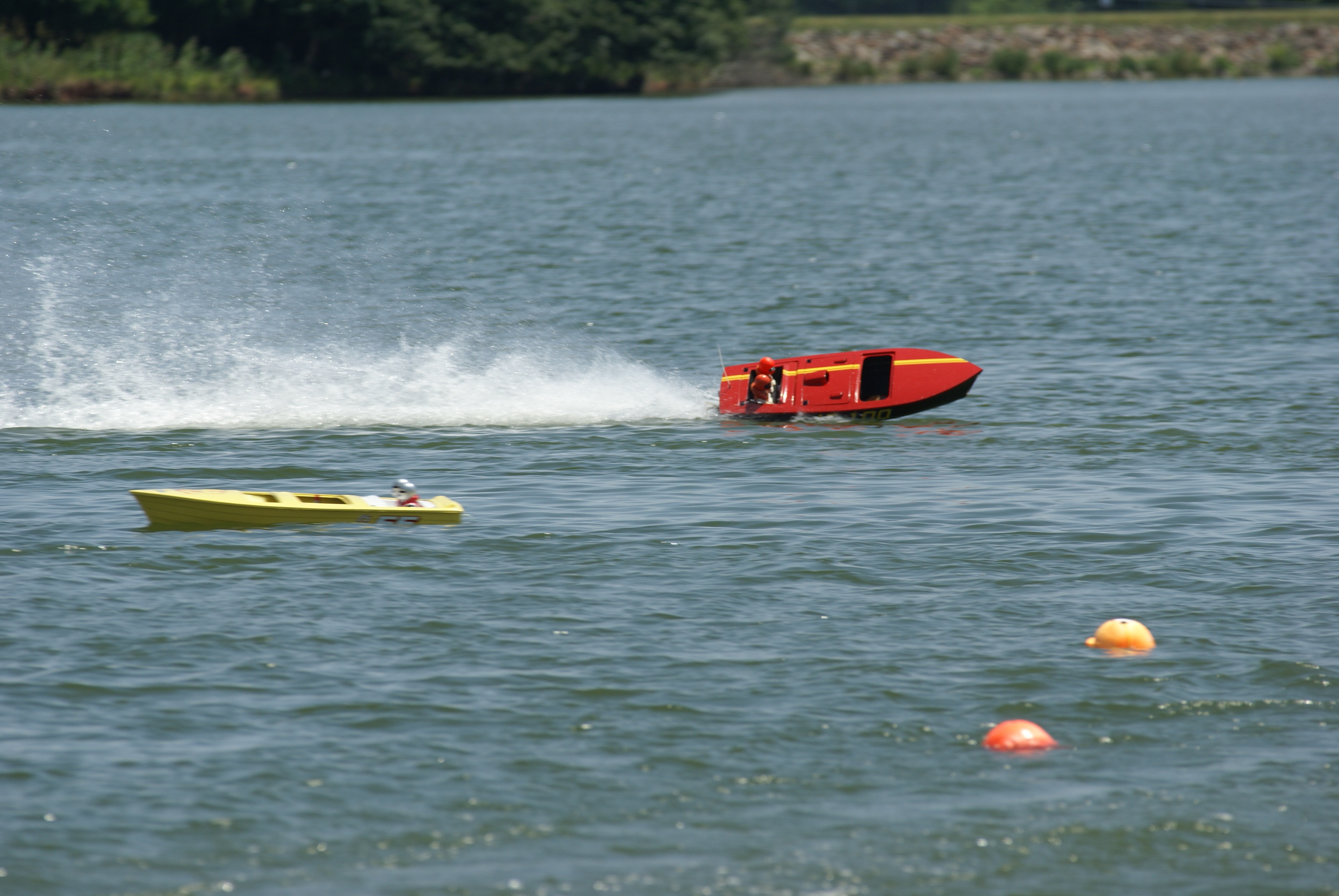
After completing six laps of racing, the heat is over for you. Gas and nitro boats will do a cool down lap before bringing in their boats in. Make sure you give way to all boats that are still racing while on your cool down lap. When you bring you boat in, run parallel to shore and cut off the motor before turning it in toward shore. On occasion, a motor will not shut down and when this happens, it's safer to have the boat running parallel to shore rather than pointed directly at your pit man. FE boats in our district have the option of pulling into the infield after completing their heat. This keeps them from possibly over discharging their packs and keeps the motor and ESC from overheating. The FE's will hold in the infield until all the internal combustion boats are recovered and then they can be brought in. After your boat is picked up by the pit man, can grab your boat, turn off the receiver first and then the transmitter. If you used a frequency clip, remove it from your transmitter, put it back on the board and return your transmitter to impound. Now you can take your boat back to your pit area.
If you are running a FE boat and it is disabled during the heat, make sure you keep your transmitter on and your fingers clear of the trigger while the boat is being retrieved. Whenever possible, use a FE racer to retrieve FE boats. If that is not an option, ensure the boat retrieval person is aware that they need to keep clear of the propeller at all times, even if the boat receiver is turned off. Also if the boat is upside down, it's better to keep the boat in that position during retrieval and untaping in the event water has found its way into the boat.
After you get your boat back to your pit area, FE guys can get to work taking temperatures, charging batteries and getting any water out of their boat. Gas and nitro guys should check their radio boxes for moisture also. Everyone then needs to check out the overall condition of your boat. Don’t take anything for granted; check every screw, nut, coupler, and wire connector. If you hit anything or bumped a boat, check for bent rudders and make sure none of your hardware got knocked out of alignment. FE guys, Make sure you charge you batteries on a non-flammable surface and have a fire extinguisher or other extinguishing agent close by such as a bucket of sand.
After you are done going over the boat and have the batteries on the charger or the fuel cell topped off, relax and make some friends. That's what this hobby is all about. If you really want to score points and have extra time between heats, ask the host club if they need any help. Even if not needed, any offer will be much appreciated.
Race weekends in D12 usually consist of 4 heats for every class (time permitting) with two to two and a half rounds of heats run on Saturday. After heats are complete on Saturday, contestants will pack up their boats and gear before heading back to their campground or hotel. It is customary in for us to leave our canopy frames up for the night however racers will remove their tops in case strong winds kick up overnight. We have had some unexpected storms pop up in the past which lead to canopies in the pond when we arrived on Sunday morning. Some racers will choose to leave their tables, but will fold them up or turn them upside down so they lay flat on the ground. Security is not guaranteed at most sites so use your own discretion if you choose to do this.
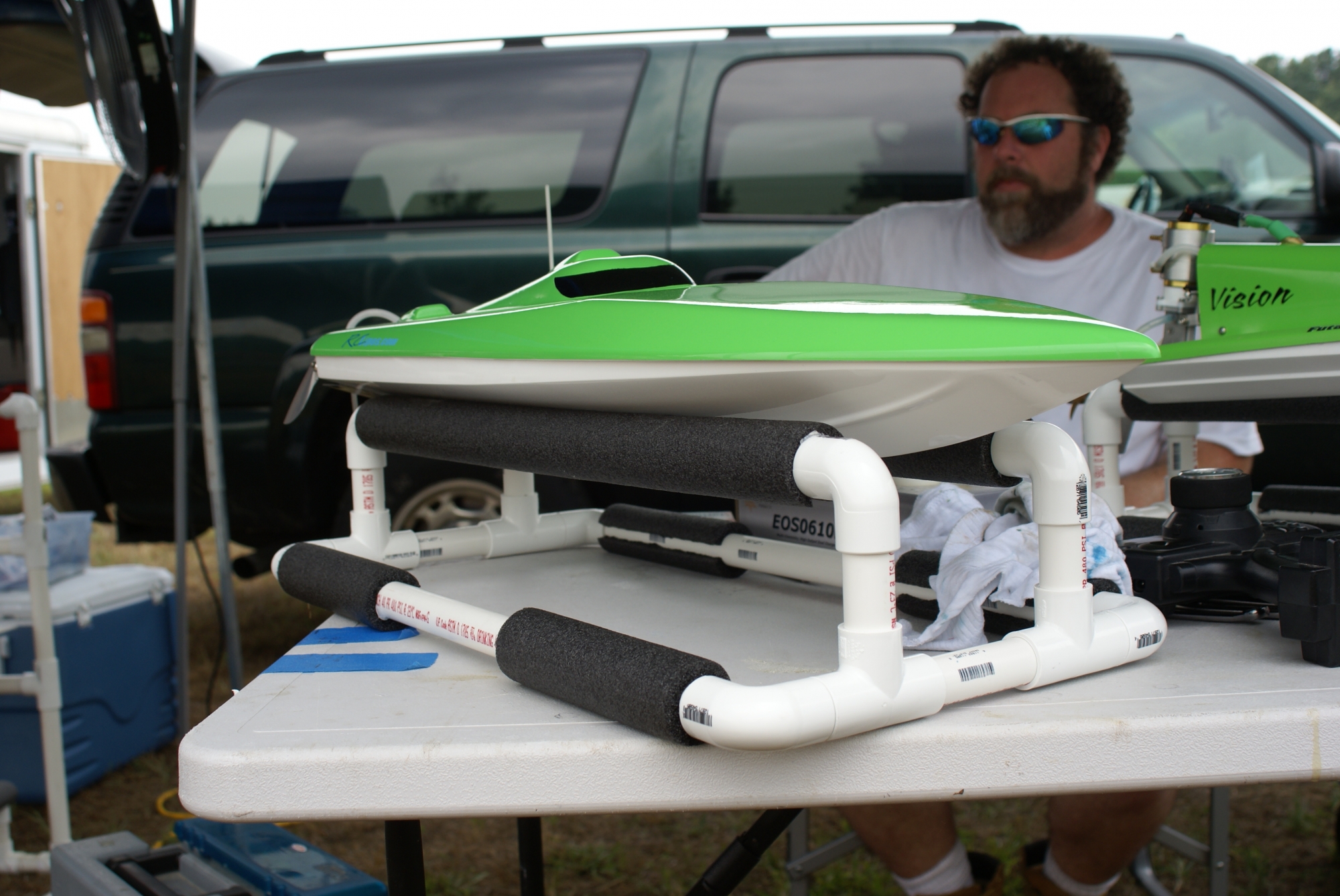
On Sunday morning give yourself plenty of time to get set up as things usually get rolling quicker than on Saturday. There may be a short drivers meeting and the racing will resume. When all the heats are complete, the host club will tally all the points for each class and awards will be given out to participants. There may be a raffle held by the host club to help defray the cost for the event or for charity. Try to patronize the club if possible by buying a few tickets. My club breaks even on entry fee's and the raffle money allows us to put a little money in our bank account for a rainy day. Raffle winners will be picked during the awards ceremony. Most of the prizes are donated by RC manufacturers and hobby shops. Try to support those the give to the hobby even if it's just a word of thanks. We try to wrap things up by the early afternoon so out-of-towners will have plenty of time to get home and unpack.
Model boat racing offers many rewards for boaters seeking a new challenge. The spirit of friendly competition and exchange of knowledge enhance our enjoyment of the hobby. But what I have found most enriching is the people I have met over the years while racing. I have been told many times from racers who came from other competitive hobbies that model boaters will make more effort to help each other than any other group. I've seen racers helping each other even when competing in the same class for district championships. If you have ever thought about taking model boating to the next level, I hope to have motivated you into taking the plunge. If you have never given it a thought, I hope to have piqued your interest.